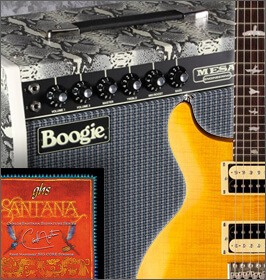After only offering his original signature model (now called the PRS Santana I guitar) for a several years, Carlos Santana and Paul Reed Smith decided to offer what can only be termed an upgrade. Certainly the cost nearly doubled, from a street price of $4,000 – $5,000 for the Santana I, to $7,000 – $8,000 for the Santana II. But that wasn’t the only change.
 Moving Up to the Santana II Model
Moving Up to the Santana II Model
Some of the changes involved the materials. The top of the body of Paul Reed Smith’s sophomore Santana guitar, in particular, features some extraordinary flamed Maple, with the grain virtually popping out of the instrument. The high-gloss Rosewood overlay on the headstock is striking as well.
The decorative body inlays (called “Purfling”) run from the tailpiece to the bridge, as well as between the pickups. They are made from abalone (sometimes called “mother of pearl”), a distinctive iridescent material harvested from seashells.
 Santana Guitar’s Big, Fat Neck
Santana Guitar’s Big, Fat Neck
All Paul Reed Smith Santana Guitar necks are labeled “Santana wide fat” by PRS. While most guitarists don’t seem to have a problem with it, some mind the size. (One player in an online review went so far as to describe it as a “baseball bat.”) There is a value, however, in such a large neck — especially for a guitarist who is playing many hours daily. It places the left hand in a more open position, so that the incidence of tendinitis, tendinitis, and other RSI conditions are reduced.
For most Santana Guitars, the fret-board radius is 10″, which is a medium curvature. On the Santana I and Santana II, however, it has been flattened even more, to a radius of 11.5″.
 Not Just “Santana Yellow”
Not Just “Santana Yellow”
One of the most dramatic differences between the Santana I and Santana II guitars is the number of color/finish choices. While the original PRS Santana Signature model came in only one color (“Santana Yellow”), the Santana II was available in over 20 colors! (See PRS Santana II Guitar Colors sidebar for full list.)
 Switching the Switch
Switching the Switch
The original Santana guitar featured a quirky 2-mini-toggle arrangement for pickup selection; all other Santana guitars (including the Santana II) have a more traditional 3-way toggle switch. Like classic Gibson switches, the pickups are activated by the following positions: Neck (top), Neck and Bridge (middle), Bridge (bottom).
 Long Run of the 2nd Santana Guitar
Long Run of the 2nd Santana Guitar
Though it was an extraordinarily high-priced instrument, Paul Reed Smith’s Santana II guitar was offered for nearly nine years (1999 to 2007). It’s a testament to the guitar’s quality that even used models generally sell in the $5,000 to $6,000 range.
On the other hand, resistance to the cost probably helped to spur the introduction of the next model in the series, the Santana III, approximately a year after the launch of the Santana II.



